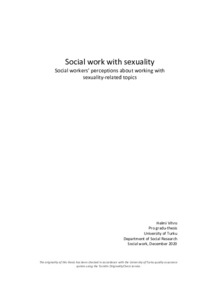Sexual communication and sexual self-disclosure in intimate relationships: associations with the frequency and consequences of sexual compliance
Kosunen, Saara (2025-06-18)
Sexual communication and sexual self-disclosure in intimate relationships: associations with the frequency and consequences of sexual compliance
Kosunen, Saara
(18.06.2025)
Lataukset:
Julkaisu on tekijänoikeussäännösten alainen. Teosta voi lukea ja tulostaa henkilökohtaista käyttöä varten. Käyttö kaupallisiin tarkoituksiin on kielletty.
avoin
Julkaisun pysyvä osoite on:
https://urn.fi/URN:NBN:fi-fe2025062573985
https://urn.fi/URN:NBN:fi-fe2025062573985
Tiivistelmä
Sexual compliance refers to consenting to sexual activity despite a lack of desire. Prior research has identified both positive and negative consequences of sexual compliance, with notable gender-related differences. Understanding when sexual compliance is beneficial or harmful requires investigating various aspects of sexual relationships. The current study aimed to investigate how sexual communication and sexual self-disclosure are associated with frequency and perceived consequences of sexual compliance, while also exploring the potential moderating role of gender. The sample consisted of 1,279 participants, who were recruited through a postal invitation to an online survey. Participants were aged from 18 to 64 and were in an intimate relationship with at least one partner. Statistical analyses were conducted with independent samples t-tests, Spearman’s rank-order correlations, Pearson’s two-tailed correlations, and two separate multiple linear regression models. The findings revealed that greater comfort with sexual communication was linked to more positive and fewer negative consequences of sexual compliance, with stronger associations observed in women compared to men. Sexual self-disclosure did not independently contribute to the variance in the perceived consequences of sexual compliance. No significant associations were found between sexual communication, sexual self-disclosure, and the frequency of sexual compliance, which indicates that these factors do not directly impact the frequency in this sample. These results underscore the importance of dyadic sexual communication in shaping the perceived consequences of sexual compliance. Future research should further investigate how the dyadic context and evolution of sexual communication, particularly as relationship progress in duration, are associated with the perceived consequences of sexual compliance in intimate relationships.
Samankaltainen aineisto
Näytetään aineisto, joilla on samankaltaisia nimekkeitä, tekijöitä tai asiasanoja.
-
The Perceived Consequences of Sexual Compliance: The Role of Sexual Pressure From the Partner and Previous Nonconsensual Sexual Experiences
Viitanen, Saara (13.05.2025)Sexual compliance means engaging in consensual sexual activity despite a lack of sexual desire and in the absence of explicit outside pressure. Sexual compliance is common in intimate relationships and can have both positive ...avoin -
Construction of a deception resistant questionnaire for alleged child sexual abuse victims : enhancing the Finnish Investigative Instrument of Child Sexual Abuse (FICSA)
Haajanen, Juulia (02.05.2019)The prevalence of child sexual abuse (CSA) is seemingly decreasing, but at the same time the number of reported CSA cases is rising, indicating that also unfounded CSA allegations are being processed by the authorities. ...suljettu -
Social work with sexuality : Social workers' perceptions about working with sexuality-related topics
Vihro, Helmi (12.12.2020)The subject of this study is sexuality-related topics in social work. Sexuality is a significant component in human well-being, and thus it can be seen as relevant for social work as well. In my study, I am examining social ...avoin


